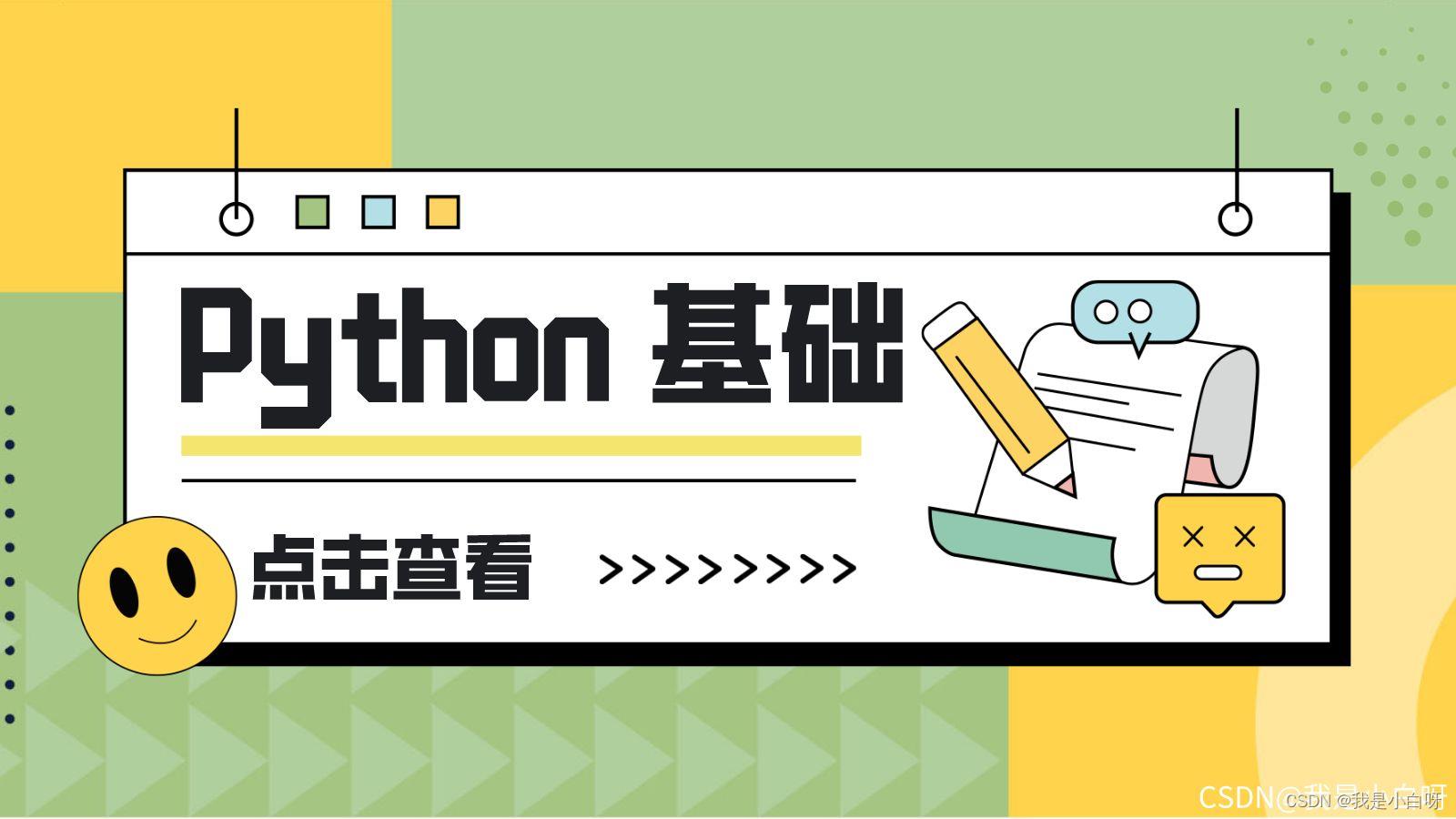Python 基础 2022 最新练习 1
Posted 我是小白呀
tags:
篇首语:本文由小常识网(cha138.com)小编为大家整理,主要介绍了Python 基础 2022 最新练习 1相关的知识,希望对你有一定的参考价值。
【Python 基础 2022 最新】练习 1
概述
从今天开始, 小白我将带领大家学习一下 Python 零基础入门的内容. 本专栏会以讲解 + 练习的模式, 带领大家熟悉 Python 的语法, 应用, 以及代码的基础逻辑.

第一题

def check_types():
## Check the data types
# a. 45
# example solution
print(type(45))
# the value 45 is classified as an integer in python
# b. 27.27
# the value 27.27 is classified as a float in python
# c. True
# the value True is classified as a boolean in python
# d. [3, 4, 5, 6]
# the value [3, 4, 5, 6] is classified as a list in python
# e. 'hello'
# the value 'hello' is classified as a string in python
check_types()
预期输出:
<class 'int'>
<class 'float'>
<class 'bool'>
<class 'list'>
<class 'str'>
第二题

def basic_opp(x,y):
# a. exponentiation (power 2)
print(x**2)
# b. multiplication
print(x*y)
# c. division (y divided by x)
print(round(y/x,2)) # this rounds the resulting value to two decimal places
# d. integer division (y divided by x)
print(y//x)
# e. the modulus operator (y modulo x)
print(y%x)
# set some sample values
a=6
b=8
# run the program
basic_opp(a,b)
预期输出:
36
48
1.33
1
2
第三题

def string_opp(y):
# a. In one line, print the first and last characters in the string.
# b. Print the 6th character in the string.
# c. Slice off first 5 and last 18 char. result: "listen to your heart"
# d. Find first instance of letter 'n' in string y.
# e. Search for '!' in string y.
# f. Split the string on each space.
# g. Combine elements of list z to generate the full sentence as in string y.
# define the string
s="just listen to your heart, that's what I do"
# run the program
string_opp(s)
预期输出:
j o
l
listen to your heart
10
-1
['just', 'listen', 'to', 'your', 'heart,', "that's", 'what', 'I', 'do']
just listen to your heart, that's what I do
第四题

def boolean_opp(a,b):
# a.
# b.
# c.
# d.
# define some sample data
n1=7
n2=9
# run the program
boolean_opp(n1,n2)
预期结果:
True
False
False
True
第一题 (答案)
def check_types():
## Check the data types
# a. 45
# example solution
print(type(45))
# the value 45 is classified as an integer in python
# b. 27.27
print(type(27.27))
# the value 27.27 is classified as a float in python
# c. True
print(type(True))
# the value True is classified as a boolean in python
# d. [3, 4, 5, 6]
print(type([3, 4, 5, 6]))
# the value [3, 4, 5, 6] is classified as a list in python
# e. 'hello'
print(type('hello'))
# the value 'hello' is classified as a string in python
check_types()
第二题 (答案)
def basic_opp(x,y):
# a. exponentiation (power 2)
print(x**2)
# b. multiplication
print(x*y)
# c. division (y divided by x)
print(round(y/x,2)) # this rounds the resulting value to two decimal places
# d. integer division (y divided by x)
print(y//x)
# e. the modulus operator (y modulo x)
print(y%x)
# set some sample values
a=6
b=8
# run the program
basic_opp(a,b)
第三题 (答案)
def string_opp(y):
# a. In one line, print the first and last characters in the string.
print(y[0],y[-1])
# b. Print the 6th character in the string.
print(y[5])
# c. Slice off first 5 and last 18 char. result: "listen to your heart"
print(y[5:-18])
# d. Find first instance of letter 'n' in string y.
print(y.find('n'))
# e. Search for '!' in string y.
print(y.find('!'))
# f. Split the string on each space.
print(y.split(' '))
# g. Combine elements of list z to generate the full sentence as in string y.
z=['just', 'listen', 'to', 'your', 'heart,', "that's", 'what', 'I', 'do']
print(' '.join(z))
# define the string
s="just listen to your heart, that's what I do"
# run the program
string_opp(s)
第四题 (答案)
def boolean_opp(a,b):
# a.
print(a>4 or b<4)
# b.
print(not(a>4 or b>4))
# c.
print((a>4 and b<4) or (a<4 and b>4))
# d.
print((a>4 or b<4) and (a<4 or b>4))
# define some sample data
n1=7
n2=9
# run the program
boolean_opp(n1,n2)
以上是关于Python 基础 2022 最新练习 1的主要内容,如果未能解决你的问题,请参考以下文章